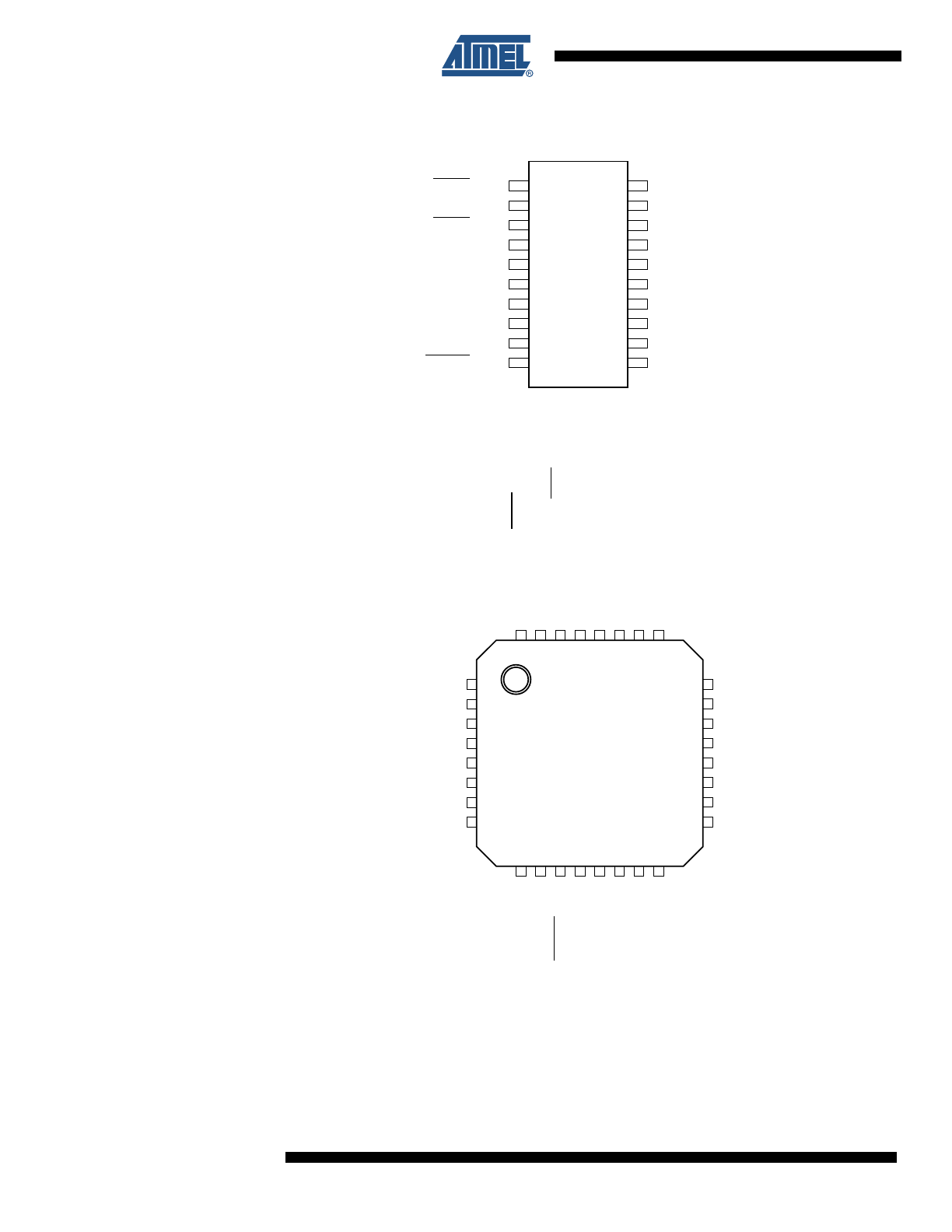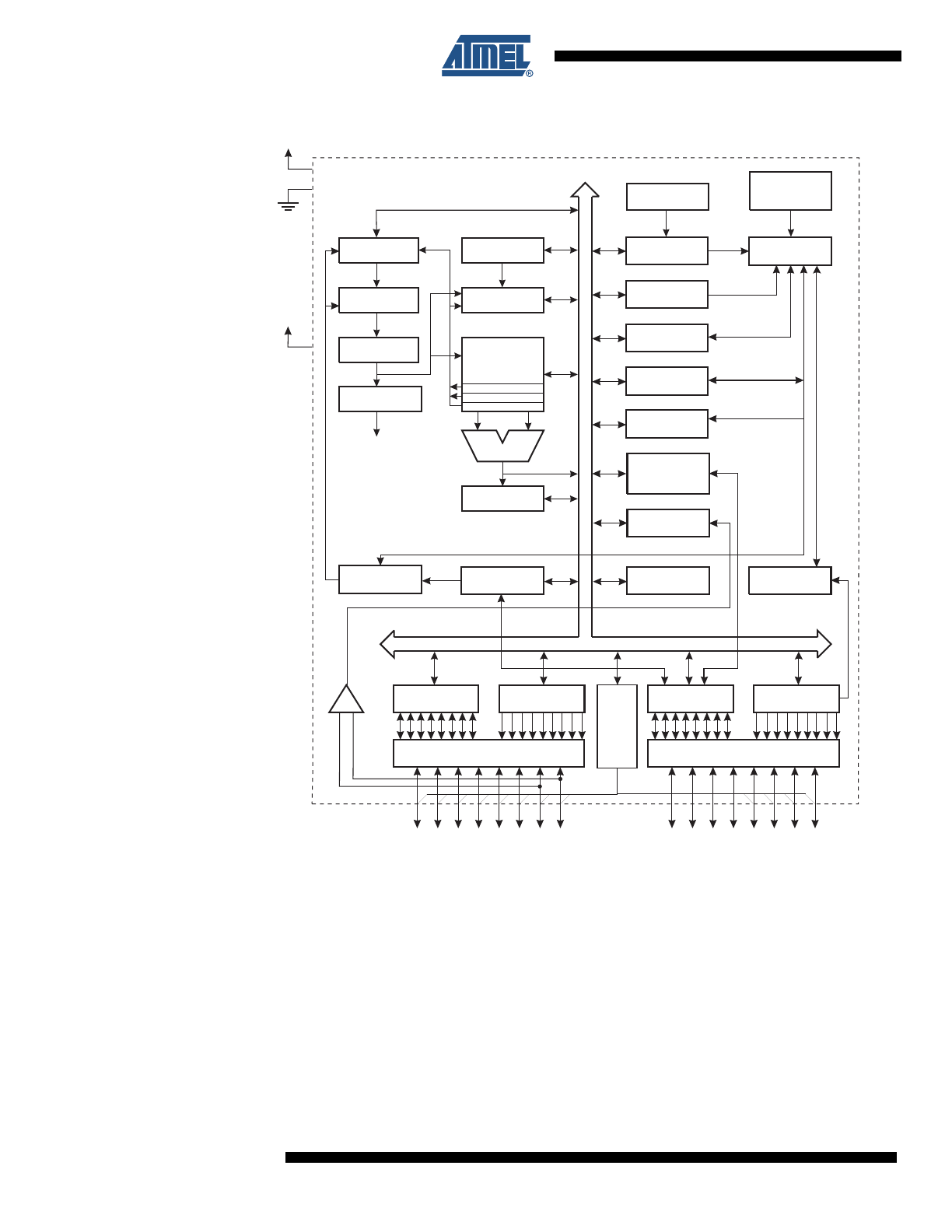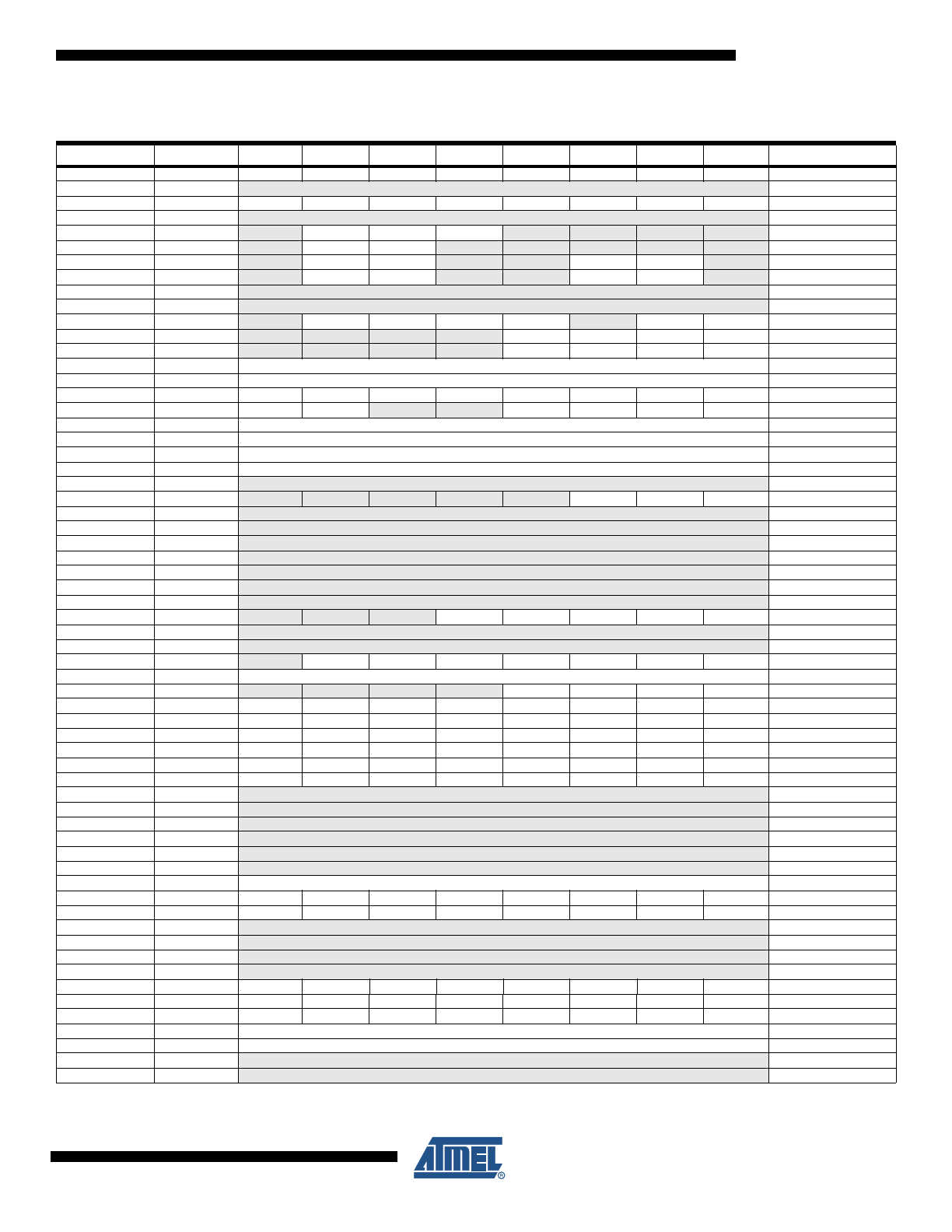
Features
•
High-performance, Low-power AVR
®
8-bit Microcontroller
•
RISC Architecture
– 118 Powerful Instructions – Most Single Clock Cycle Execution
– 32 x 8 General Purpose Working Registers
– Fully Static Operation
– Up to 16 MIPS Throughput at 16 MHz
•
Data and Non-volatile Program Memory
– 2K Bytes of In-System Programmable Program Memory Flash
Endurance: 10,000 Write/Erase Cycles
– 128 Bytes of In-System Programmable EEPROM
Endurance: 100,000 Write/Erase Cycles
– 128 Bytes Internal SRAM
– Programming Lock for Flash Program and EEPROM Data Security
•
Peripheral Features
– 8-bit Timer/Counter with Separate Prescaler
– 8-bit High-speed Timer with Separate Prescaler
2 High Frequency PWM Outputs with Separate Output Compare Registers
Non-overlapping Inverted PWM Output Pins
– Universal Serial Interface with Start Condition Detector
– 10-bit ADC
11 Single Ended Channels
8 Differential ADC Channels
7 Differential ADC Channel Pairs with Programmable Gain (1x, 20x)
– On-chip Analog Comparator
– External Interrupt
– Pin Change Interrupt on 11 Pins
– Programmable Watchdog Timer with Separate On-chip Oscillator
•
Special Microcontroller Features
– Low Power Idle, Noise Reduction, and Power-down Modes
– Power-on Reset and Programmable Brown-out Detection
– External and Internal Interrupt Sources
– In-System Programmable via SPI Port
– Internal Calibrated RC Oscillator
•
I/O and Packages
– 20-lead PDIP/SOIC: 16 Programmable I/O Lines
– 32-lead QFN/MLF: 16 programmable I/O Lines
•
Operating Voltages
– 2.7V - 5.5V for ATtiny26L
– 4.5V - 5.5V for ATtiny26
•
Speed Grades
– 0 - 8 MHz for ATtiny26L
– 0 - 16 MHz for ATtiny26
•
Power Consumption at 1 MHz, 3V and 25
°C for ATtiny26L
– Active 16 MHz, 5V and 25
°C: Typ 15 mA
– Active 1 MHz, 3V and 25
°C: 0.70 mA
– Idle Mode 1 MHz, 3V and 25
°C: 0.18 mA
– Power-down Mode: < 1 µA
8-bit
Microcontroller
with 2K Bytes
Flash
ATtiny26
ATtiny26L
Summary
1477KS–AVR–08/10

2
1477KS–AVR–08/10
ATtiny26(L)
Pin
Configuration
Note:
The bottom pad under the QFN/MLF package should be soldered to ground.
1
2
3
4
5
6
7
8
9
10
20
19
18
17
16
15
14
13
12
11
(MOSI/DI/SDA/OC1A) PB0
(MISO/DO/OC1A) PB1
(SCK/SCL/OC1B) PB2
(OC1B) PB3
VCC
GND
(ADC7/XTAL1) PB4
(ADC8/XTAL2) PB5
(ADC9/INT0/T0) PB6
(ADC10/RESET) PB7
PA0 (ADC0)
PA1 (ADC1)
PA2 (ADC2)
PA3 (AREF)
GND
AVCC
PA4 (ADC3)
PA5 (ADC4)
PA6 (ADC5/AIN0)
PA7 (ADC6/AIN1)
PDIP/SOIC
1
2
3
4
5
6
7
8
24
23
22
21
20
19
18
17
32
31
30
29
28
27
26
25
9
10
11
12
13
14
15
16
MLF Top View
NC
(OC1B) PB3
NC
VCC
GND
NC
(ADC7/XTAL1) PB4
(ADC8/XTAL2) PB5
NC
PA2 (ADC2)
PA3 (AREF)
GND
NC
NC
AVCC
PA4 (ADC3)
NC
(ADC9/INT0/T0) PB6
(ADC10/RESET) PB7
NC
(ADC6/AIN1) PA7
(ADC5/AIN0) PA6
(ADC4) PA5
NC
PB2 (SCK/SCL/OC1B)
PB1 (MISO/DO/OC1A)
PB0 (MOSI/DI/SDA/OC1A)
NC
NC
NC
PA0 (ADC0)
PA1 (ADC1)

3
1477KS–AVR–08/10
ATtiny26(L)
Description
The ATtiny26(L) is a low-power CMOS 8-bit microcontroller based on the AVR enhanced RISC
architecture. By executing powerful instructions in a single clock cycle, the ATtiny26(L) achieves
throughputs approaching 1 MIPS per MHz allowing the system designer to optimize power con-
sumption versus processing speed.
The AVR core combines a rich instruction set with 32 general purpose working registers. All the
32 registers are directly connected to the Arithmetic Logic Unit (ALU), allowing two independent
registers to be accessed in one single instruction executed in one clock cycle. The resulting
architecture is more code efficient while achieving throughputs up to ten times faster than con-
ventional CISC microcontrollers. The ATtiny26(L) has a high precision ADC with up to 11 single
ended channels and 8 differential channels. Seven differential channels have an optional gain of
20x. Four out of the seven differential channels, which have the optional gain, can be used at the
same time. The ATtiny26(L) also has a high frequency 8-bit PWM module with two independent
outputs. Two of the PWM outputs have inverted non-overlapping output pins ideal for synchro-
nous rectification. The Universal Serial Interface of the ATtiny26(L) allows efficient software
implementation of TWI (Two-wire Serial Interface) or SM-bus interface. These features allow for
highly integrated battery charger and lighting ballast applications, low-end thermostats, and
firedetectors, among other applications.
The ATtiny26(L) provides 2K bytes of Flash, 128 bytes EEPROM, 128 bytes SRAM, up to 16
general purpose I/O lines, 32 general purpose working registers, two 8-bit Timer/Counters, one
with PWM outputs, internal and external Oscillators, internal and external interrupts, program-
mable Watchdog Timer, 11-channel, 10-bit Analog to Digital Converter with two differential
voltage input gain stages, and four software selectable power saving modes. The Idle mode
stops the CPU while allowing the Timer/Counters and interrupt system to continue functioning.
The ATtiny26(L) also has a dedicated ADC Noise Reduction mode for reducing the noise in ADC
conversion. In this sleep mode, only the ADC is functioning. The Power-down mode saves the
register contents but freezes the oscillators, disabling all other chip functions until the next inter-
rupt or hardware reset. The Standby mode is the same as the Power-down mode, but external
oscillators are enabled. The wakeup or interrupt on pin change features enable the ATtiny26(L)
to be highly responsive to external events, still featuring the lowest power consumption while in
the Power-down mode.
The device is manufactured using Atmel’s high density non-volatile memory technology. By
combining an enhanced RISC 8-bit CPU with Flash on a monolithic chip, the ATtiny26(L) is a
powerful microcontroller that provides a highly flexible and cost effective solution to many
embedded control applications.
The ATtiny26(L) AVR is supported with a full suite of program and system development tools
including: Macro assemblers, program debugger/simulators, In-circuit emulators, and evaluation
kits.

4
1477KS–AVR–08/10
ATtiny26(L)
Block Diagram
Figure 1. The ATtiny26(L) Block Diagram
WATCHDOG
TIMER
MCU CONTROL
REGISTER
UNIVERSAL
SERIAL
INTERFACE
TIMER/
COUNTER0
DATA DIR.
REG.PORT A
DATA REGISTER
PORT A
PROGRAMMING
LOGIC
TIMING AND
CONTROL
TIMER/
COUNTER1
MCU STATUS
REGISTER
PORT A DRIVERS
PA0-PA7
VCC
GND
+
-
ANALOG
COMPARATOR
8-BIT DATA BUS
ADC
ISP INTERFACE
INTERRUPT
UNIT
EEPROM
INTERNAL
OSCILLATOR
OSCILLATORS
CALIBRATED
OSCILLATOR
INTERNAL
DATA DIR.
REG.PORT B
DATA REGISTER
PORT B
PORT B DRIVERS
PB0-PB7
PROGRAM
COUNTER
STACK
POINTER
PROGRAM
FLASH
SRAM
GENERAL
PURPOSE
REGISTERS
INSTRUCTION
REGISTER
INSTRUCTION
DECODER
STATUS
REGISTER
Z
Y
X
ALU
CONTROL
LINES
AVCC

5
1477KS–AVR–08/10
ATtiny26(L)
Pin Descriptions
VCC
Digital supply voltage pin.
GND
Digital ground pin.
AVCC
AVCC is the supply voltage pin for Port A and the A/D Converter (ADC). It should be externally
connected to V
CC
, even if the ADC is not used. If the ADC is used, it should be connected to V
CC
through a low-pass filter. See page 94 for details on operating of the ADC.
Port A (PA7..PA0)
Port A is an 8-bit general purpose I/O port. PA7..PA0 are all I/O pins that can provide internal
pull-ups (selected for each bit). Port A has alternate functions as analog inputs for the ADC and
analog comparator and pin change interrupt as described in “Alternate Port Functions” on page
46.
Port B (PB7..PB0)
Port B is an 8-bit general purpose I/O port. PB6..0 are all I/O pins that can provide internal pull-
ups (selected for each bit). PB7 is an I/O pin if not used as the reset. To use pin PB7 as an I/O
pin, instead of RESET pin, program (“0”) RSTDISBL Fuse. Port B has alternate functions for the
ADC, clocking, timer counters, USI, SPI programming, and pin change interrupt as described in
“Alternate Port Functions” on page 46.
An External Reset is generated by a low level on the PB7/RESET pin. Reset pulses longer than
50 ns will generate a reset, even if the clock is not running. Shorter pulses are not guaranteed to
generate a reset.
XTAL1
Input to the inverting oscillator amplifier and input to the internal clock operating circuit.
XTAL2
Output from the inverting oscillator amplifier.

6
1477KS–AVR–08/10
ATtiny26(L)
General
Information
Resources
A comprehensive set of development tools, application notes and datasheets are available for
download on http://www.atmel.com/avr.
Code Examples
This datasheet contains simple code examples that briefly show how to use various parts of the
device. These code examples assume that the part specific header file is included before compi-
lation. Be aware that not all C compiler vendors include bit definitions in the header files and
interrupt handling in C is compiler dependent. Please confirm with the C compiler documentation
for more details.

7
1477KS–AVR–08/10
ATtiny26(L)
Register Summary
Address
Name
Bit 7
Bit 6
Bit 5
Bit 4
Bit 3
Bit 2
Bit 1
Bit 0
Page
$3F ($5F)
SREG
I
T
H
S
V
N
Z
C
10
$3E ($5E)
Reserved
$3D ($5D)
SP
SP7
SP6
SP5
SP4
SP3
SP2
SP1
SP0
11
$3C ($5C)
Reserved
$3B ($5B)
GIMSK
-
INT0
PCIE1
PCIE0
-
-
-
-
58
$3A ($5A)
GIFR
-
INTF0
PCIF
-
-
-
-
-
59
$39 ($59)
TIMSK
-
OCIE1A
OCIE1B
-
-
TOIE1
TOIE0
-
59
$38 ($58)
TIFR
-
OCF1A
OCF1B
-
-
TOV1
TOV0
-
60
$37 ($57)
Reserved
$36 ($56)
Reserved
$35 ($55)
MCUCR
-
PUD
SE
SM1
SM0
-
ISC01
ISC00
37
$34 ($54)
MCUSR
-
-
-
-
WDRF
BORF
EXTRF
PORF
36
$33 ($53)
TCCR0
-
-
-
-
PSR0
CS02
CS01
CS00
66
$32 ($52)
TCNT0
Timer/Counter0 (8-Bit)
67
$31 ($51)
OSCCAL
Oscillator Calibration Register
29
$30 ($50)
TCCR1A
COM1A1
COM1A0
COM1B1
COM1B0
FOC1A
FOC1B
PWM1A
PWM1B
70
$2F ($4F)
TCCR1B
CTC1
PSR1
-
-
CS13
CS12
CS11
CS10
71
$2E ($4E)
TCNT1
Timer/Counter1 (8-Bit)
72
$2D ($4D)
OCR1A
Timer/Counter1 Output Compare Register A (8-Bit)
72
$2C ($4C)
OCR1B
Timer/Counter1 Output Compare Register B (8-Bit)
73
$2B ($4B)
OCR1C
Timer/Counter1 Output Compare Register C (8-Bit)
73
$2A ($4A)
Reserved
$29 ($49)
PLLCSR
-
-
-
-
-
PCKE
PLLE
PLOCK
$28 ($48)
Reserved
$27 ($47)
Reserved
$26 ($46)
Reserved
$25 ($45)
Reserved
$24 ($44)
Reserved
$23 ($43)
Reserved
$22 ($42)
Reserved
$21 ($41)
WDTCR
-
-
-
WDCE
WDE
WDP2
WDP1
WDP0
78
$20 ($40)
Reserved
$1F ($3F)
Reserved
$1E ($3E)
EEAR
-
EEAR6
EEAR5
EEAR4
EEAR3
EEAR2
EEAR1
EEAR0
18
$1D ($3D)
EEDR
EEPROM Data Register (8-Bit)
19
$1C ($3C)
EECR
-
-
-
-
EERIE
EEMWE
EEWE
EERE
19
$1B ($3B)
PORTA
PORTA7
PORTA6
PORTA5
PORTA4
PORTA3
PORTA2
PORTA1
PORTA0
$1A ($3A)
DDRA
DDA7
DDA6
DDA5
DDA4
DDA3
DDA2
DDA1
DDA0
$19 ($39)
PINA
PINA7
PINA6
PINA5
PINA4
PINA3
PINA2
PINA1
PINA0
$18 ($38)
PORTB
PORTB7
PORTB6
PORTB5
PORTB4
PORTB3
PORTB2
PORTB1
PORTB0
$17 ($37)
DDRB
DDB7
DDB6
DDB5
DDB4
DDB3
DDB2
DDB1
DDB0
$16 ($36)
PINB
PINB7
PINB6
PINB5
PINB4
PINB3
PINB2
PINB1
PINB0
$15 ($35)
Reserved
$14 ($34)
Reserved
$13 ($33)
Reserved
$12 ($32)
Reserved
$11 ($31)
Reserved
$10 ($30)
Reserved
$0F ($2F)
USIDR
Universal Serial Interface Data Register (8-Bit)
81
$0E ($2E)
USISR
USISIF
USIOIF
USIPF
USIDC
USICNT3
USICNT2
USICNT1
USICNT0
81
$0D ($2D)
USICR
USISIE
USIOIE
USIWM1
USIWM0
USICS1
USICS0
USICLK
USITC
82
$0C ($2C)
Reserved
$0B ($2)B
Reserved
$0A ($2A)
Reserved
$09 ($29)
Reserved
$08 ($28)
ACSR
ACD
ACBG
ACO
ACI
ACIE
ACME
ACIS1
ACIS0
91
$07 ($27)
ADMUX
REFS1
REFS0
ADLAR
MUX4
MUX3
MUX2
MUX1
MUX0
101
$06 ($26)
ADCSR
ADEN
ADSC
ADFR
ADIF
ADIE
ADPS2
ADPS1
ADPS0
103
$05 ($25)
ADCH
ADC Data Register High Byte
104
$04 ($24)
ADCL
ADC Data Register Low Byte
104
…
Reserved
$00 ($20)
Reserved

8
1477KS–AVR–08/10
ATtiny26(L)
Instruction Set Summary
Mnemonic
Operands
Description
Operation
Flags
# Clocks
ARITHMETIC AND LOGIC INSTRUCTIONS
ADD
Rd, Rr
Add Two Registers
Rd
← Rd + Rr
Z,C,N,V,H
1
ADC
Rd, Rr
Add with Carry Two Registers
Rd
← Rd + Rr + C
Z,C,N,V,H
1
ADIW
Rdl, K
Add Immediate to Word
Rdh:Rdl
← Rdh:Rdl + K
Z,C,N,V,S
2
SUB
Rd, Rr
Subtract Two Registers
Rd
← Rd - Rr
Z,C,N,V,H
1
SUBI
Rd, K
Subtract Constant from Register
Rd
← Rd - K
Z,C,N,V,H
1
SBC
Rd, Rr
Subtract with Carry Two Registers
Rd
← Rd - Rr - C
Z,C,N,V,H
1
SBCI
Rd, K
Subtract with Carry Constant from Reg.
Rd
← Rd - K - C
Z,C,N,V,H
1
SBIW
Rdl, K
Subtract Immediate from Word
Rdh:Rdl
← Rdh:Rdl - K
Z,C,N,V,S
2
AND
Rd, Rr
Logical AND Registers
Rd
← Rd • Rr
Z,N,V
1
ANDI
Rd, K
Logical AND Register and Constant
Rd
← Rd • K
Z,N,V
1
OR
Rd, Rr
Logical OR Registers
Rd
← Rd v Rr
Z,N,V
1
ORI
Rd, K
Logical OR Register and Constant
Rd
← Rd v K
Z,N,V
1
EOR
Rd, Rr
Exclusive OR Registers
Rd
← Rd ⊕ Rr
Z,N,V
1
COM
Rd
One’s Complement
Rd
← $FF - Rd
Z,C,N,V
1
NEG
Rd
Two’s Complement
Rd
← $00 - Rd
Z,C,N,V,H
1
SBR
Rd, K
Set Bit(s) in Register
Rd
← Rd v K
Z,N,V
1
CBR
Rd, K
Clear Bit(s) in Register
Rd
← Rd • ($FF - K)
Z,N,V
1
INC
Rd
Increment
Rd
← Rd + 1
Z,N,V
1
DEC
Rd
Decrement
Rd
← Rd - 1
Z,N,V
1
TST
Rd
Test for Zero or Minus
Rd
← Rd • Rd
Z,N,V
1
CLR
Rd
Clear Register
Rd
← Rd ⊕ Rd
Z,N,V
1
SER
Rd
Set Register
Rd
← $FF
None
1
BRANCH INSTRUCTIONS
RJMP
k
Relative Jump
PC
← PC + k + 1
None
2
IJMP
Indirect Jump to (Z)
PC
← Z
None
2
RCALL
k
Relative Subroutine Call
PC
← PC + k + 1
None
3
ICALL
Indirect Call to (Z)
PC
← Z
None
3
RET
Subroutine Return
PC
← STACK
None
4
RETI
Interrupt Return
PC
← STACK
I
4
CPSE
Rd, Rr
Compare, Skip if Equal
if (Rd = Rr) PC
← PC + 2 or 3
None
1/2/3
CP
Rd, Rr
Compare
Rd - Rr
Z,N,V,C,H
1
CPC
Rd, Rr
Compare with Carry
Rd - Rr - C
Z,N,V,C,H
1
CPI
Rd, K
Compare Register with Immediate
Rd - K
Z,N,V,C,H
1
SBRC
Rr, b
Skip if Bit in Register Cleared
if (Rr(b) = 0) PC
← PC + 2 or 3
None
1/2/3
SBRS
Rr, b
Skip if Bit in Register is Set
if (Rr(b) = 1) PC
← PC + 2 or 3
None
1/2/3
SBIC
P, b
Skip if Bit in I/O Register Cleared
if (P(b) = 0) PC
← PC + 2 or 3
None
1/2/3
SBIS
P, b
Skip if Bit in I/O Register is Set
if (P(b) = 1) PC
← PC + 2 or 3
None
1/2/3
BRBS
s, k
Branch if Status Flag Set
if (SREG(s) = 1) then PC
← PC + k + 1
None
1/2
BRBC
s, k
Branch if Status Flag Cleared
if (SREG(s) = 0) then PC
← PC + k + 1
None
1/2
BREQ
k
Branch if Equal
if (Z = 1) then PC
← PC + k + 1
None
1/2
BRNE
k
Branch if Not Equal
if (Z = 0) then PC
← PC + k + 1
None
1/2
BRCS
k
Branch if Carry Set
if (C = 1) then PC
← PC + k + 1
None
1/2
BRCC
k
Branch if Carry Cleared
if (C = 0) then PC
← PC + k + 1
None
1/2
BRSH
k
Branch if Same or Higher
if (C = 0) then PC
← PC + k + 1
None
1/2
BRLO
k
Branch if Lower
if (C = 1) then PC
← PC + k + 1
None
1/2
BRMI
k
Branch if Minus
if (N = 1) then PC
← PC + k + 1
None
1/2
BRPL
k
Branch if Plus
if (N = 0) then PC
← PC + k + 1
None
1/2
BRGE
k
Branch if Greater or Equal, Signed
if (N
⊕ V = 0) then PC ← PC + k + 1
None
1/2
BRLT
k
Branch if Less than Zero, Signed
if (N
⊕ V = 1) then PC ← PC + k + 1
None
1/2
BRHS
k
Branch if Half-carry Flag Set
if (H = 1) then PC
← PC + k + 1
None
1/2
BRHC
k
Branch if Half-carry Flag Cleared
if (H = 0) then PC
← PC + k + 1
None
1/2
BRTS
k
Branch if T-flag Set
if (T = 1) then PC
← PC + k + 1
None
1/2
BRTC
k
Branch if T-flag Cleared
if (T = 0) then PC
← PC + k + 1
None
1/2
BRVS
k
Branch if Overflow Flag is Set
if (V = 1) then PC
← PC + k + 1
None
1/2
BRVC
k
Branch if Overflow Flag is Cleared
if (V = 0) then PC
← PC + k + 1
None
1/2
BRIE
k
Branch if Interrupt Enabled
if (I = 1) then PC
← PC + k + 1
None
1/2
BRID
k
Branch if Interrupt Disabled
if (I = 0) then PC
← PC + k + 1
None
1/2
DATA TRANSFER INSTRUCTIONS
MOV
Rd, Rr
Move between Registers
Rd
← Rr
None
1
LDI
Rd, K
Load Immediate
Rd
← K
None
1
LD
Rd, X
Load Indirect
Rd
← (X)
None
2
LD
Rd, X+
Load Indirect and Post-inc.
Rd
← (X), X ← X + 1
None
2
LD
Rd, -X
Load Indirect and Pre-dec.
X
← X - 1, Rd ← (X)
None
2

9
1477KS–AVR–08/10
ATtiny26(L)
LD
Rd, Y
Load Indirect
Rd
← (Y)
None
2
LD
Rd, Y+
Load Indirect and Post-inc.
Rd
← (Y), Y ← Y + 1
None
2
LD
Rd, -Y
Load Indirect and Pre-dec.
Y
← Y - 1, Rd ← (Y)
None
2
LDD
Rd,Y+q
Load Indirect with Displacement
Rd
← (Y + q)
None
2
LD
Rd, Z
Load Indirect
Rd
← (Z)
None
2
LD
Rd, Z+
Load Indirect and Post-inc.
Rd
← (Z), Z ← Z + 1
None
2
LD
Rd, -Z
Load Indirect and Pre-dec.
Z
← Z - 1, Rd ← (Z)
None
2
LDD
Rd, Z+q
Load Indirect with Displacement
Rd
← (Z + q)
None
2
LDS
Rd, k
Load Direct from SRAM
Rd
← (k)
None
2
ST
X, Rr
Store Indirect
(X)
← Rr
None
2
ST
X+, Rr
Store Indirect and Post-inc.
(X)
← Rr, X ← X + 1
None
2
ST
-X, Rr
Store Indirect and Pre-dec.
X
← X - 1, (X) ← Rr
None
2
ST
Y, Rr
Store Indirect
(Y)
← Rr
None
2
ST
Y+, Rr
Store Indirect and Post-inc.
(Y)
← Rr, Y ← Y + 1
None
2
ST
-Y, Rr
Store Indirect and Pre-dec.
Y
← Y - 1, (Y) ← Rr
None
2
STD
Y+q, Rr
Store Indirect with Displacement
(Y + q)
← Rr
None
2
ST
Z, Rr
Store Indirect
(Z)
← Rr
None
2
ST
Z+, Rr
Store Indirect and Post-inc.
(Z)
← Rr, Z ← Z + 1
None
2
ST
-Z, Rr
Store Indirect and Pre-dec.
Z
← Z - 1, (Z) ← Rr
None
2
STD
Z+q, Rr
Store Indirect with Displacement
(Z + q)
← Rr
None
2
STS
k, Rr
Store Direct to SRAM
(k)
← Rr
None
2
LPM
Load Program Memory
R0
← (Z)
None
3
LPM
Rd, Z
Load Program Memory
Rd
← (Z)
None
3
IN
Rd, P
In Port
Rd
← P
None
1
OUT
P, Rr
Out Port
P
← Rr
None
1
PUSH
Rr
Push Register on Stack
STACK
← Rr
None
2
POP
Rd
Pop Register from Stack
Rd
← STACK
None
2
BIT AND BIT-TEST INSTRUCTIONS
SBI
P, b
Set Bit in I/O Register
I/O(P,b)
← 1
None
2
CBI
P, b
Clear Bit in I/O Register
I/O(P,b)
← 0
None
2
LSL
Rd
Logical Shift Left
Rd(n+1)
← Rd(n), Rd(0) ← 0
Z,C,N,V
1
LSR
Rd
Logical Shift Right
Rd(n)
← Rd(n+1), Rd(7) ← 0
Z,C,N,V
1
ROL
Rd
Rotate Left through Carry
Rd(0)
← C, Rd(n+1) ← Rd(n), C ← Rd(7)
Z,C,N,V
1
ROR
Rd
Rotate Right through Carry
Rd(7)
← C, Rd(n) ← Rd(n+1), C ← Rd(0)
Z,C,N,V
1
ASR
Rd
Arithmetic Shift Right
Rd(n)
← Rd(n+1), n = 0..6
Z,C,N,V
1
SWAP
Rd
Swap Nibbles
Rd(3..0)
← Rd(7..4), Rd(7..4) ← Rd(3..0)
None
1
BSET
s
Flag Set
SREG(s)
← 1
SREG(s)
1
BCLR
s
Flag Clear
SREG(s)
← 0
SREG(s)
1
BST
Rr, b
Bit Store from Register to T
T
← Rr(b)
T
1
BLD
Rd, b
Bit Load from T to Register
Rd(b)
← T
None
1
SEC
Set Carry
C
← 1
C
1
CLC
Clear Carry
C
← 0
C
1
SEN
Set Negative Flag
N
← 1
N
1
CLN
Clear Negative Flag
N
← 0
N
1
SEZ
Set Zero Flag
Z
← 1
Z
1
CLZ
Clear Zero Flag
Z
← 0
Z
1
SEI
Global Interrupt Enable
I
← 1
I
1
CLI
Global Interrupt Disable
I
← 0
I
1
SES
Set Signed Test Flag
S
← 1
S
1
CLS
Clear Signed Test Flag
S
← 0
S
1
SEV
Set Two’s Complement Overflow
V
← 1
V
1
CLV
Clear Two’s Complement Overflow
V
← 0
V
1
SET
Set T in SREG
T
← 1
T
1
CLT
Clear T in SREG
T
← 0
T
1
SEH
Set Half-carry Flag in SREG
H
← 1
H
1
CLH
Clear Half-carry Flag in SREG
H
← 0
H
1
NOP
No Operation
None
1
SLEEP
Sleep
(see specific descr. for Sleep function)
None
1
WDR
Watchdog Reset
(see specific descr. for WDR/timer)
None
1
Instruction Set Summary (Continued)
Mnemonic
Operands
Description
Operation
Flags
# Clocks

10
1477KS–AVR–08/10
ATtiny26(L)
Notes: 1. This device can also be supplied in wafer form. Please contact your local Atmel sales office for detailed ordering information
and minimum quantities.
2. Pb-free packaging alternative, complies to the European Directive for Restriction of Hazardous Substances (RoHS direc-
tive). Also Halide free and fully Green.
3. Code Indicators:
– U: matte tin
– R: tape & reel
Ordering Information
Speed (MHz)
Power Supply (V)
Ordering Code
(2)
Package
(2)
Operational Range
8
2.7 - 5.5
ATtiny26L-8PU
ATtiny26L-8SU
ATtiny26L-8SUR
ATtiny26L-8MU
ATtiny26L-8MUR
20P3
20S
20S
32M1-A
32M1-A
Industrial
(-40
°C to +85°C)
(1)
16
4.5 - 5.5
ATtiny26-16PU
ATtiny26-16SU
ATtiny26-16SUR
ATtiny26-16MU
ATtiny26-16MUR
20P3
20S
20S
32M1-A
32M1-A
Industrial
(-40
°C to +85°C)
(1)
Package Type
20P3
20-lead, 0.300" Wide, Plastic Dual Inline Package (PDIP)
20S
20-lead, 0.300" Wide, Plastic Gull Wing Small Outline (SOIC)
32M1-A
32-pad, 5 x 5 x 1.0 body, Lead Pitch 0.50 mm Quad Flat No-Lead/Micro Lead Frame Package (QFN/MLF)
